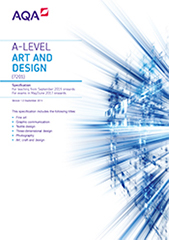3.3 Art, craft and design
Students must be introduced to a variety of experiences that explore a range of two-dimensional and/or three-dimensional media, processes and techniques. They should be made aware of both traditional and new media.
Students should explore the use of drawing for different purposes, using a variety of methods and media on a variety of scales. Students may use sketchbooks/workbooks/journals to underpin their work where appropriate.
Students should explore relevant images, artefacts and resources relating to a range of art, craft and design, from the past and from recent times, including European and non-European examples. This should be integral to the investigating and making processes. Students' responses to these examples must be shown through practical and critical activities that demonstrate their understanding of different styles, genres and traditions.
Students should be aware of the four assessment objectives to be demonstrated in the context of the content and skills presented. They should be aware of the importance of process as well as product.
Areas of study
Within each component, students must demonstrate evidence that they have explored critical and contextual work through a range of two-dimensional and/or three-dimensional processes and media.
Component 1: must show evidence of working in areas of study drawn from two or more of the endorsed titles listed below.
Component 2: must show evidence of areas of study drawn from one or more of the endorsed titles listed below.
The area(s) of study selected for Component 1 can be the same as, or different to, those selected for Component 2.
Skills and techniques
Students will be expected to demonstrate skills, as defined in Overarching knowledge, understanding and skills, in the context of their chosen areas of study.
- Fine art: for example drawing, painting, mixed-media, sculpture, ceramics, installation, printmaking, moving image (video, film, animation) and photography.
- Graphic communication: for example interactive media (including web, app and game design), advertising, packaging design, design for print, illustration, communication graphics, branding, multimedia, motion graphics, design for film and television.
- Textile design: for example fashion design, fashion textiles, costume design, digital textiles, printed and/or dyed fabrics and materials, domestic textiles, wallpaper, interior design, constructed textiles, art textiles and installed textiles.
- Three-dimensional design: for example ceramics, sculpture, exhibition design, design for theatre, television and film, interior design, product design, environmental design, architectural design, jewellery/body ornament and 3D digital design.
- Photography: for example portraiture, landscape photography, still life photography, documentary photography, photojournalism, fashion photography, experimental imagery, multimedia, photographic installation and moving image (video, film, animation).
